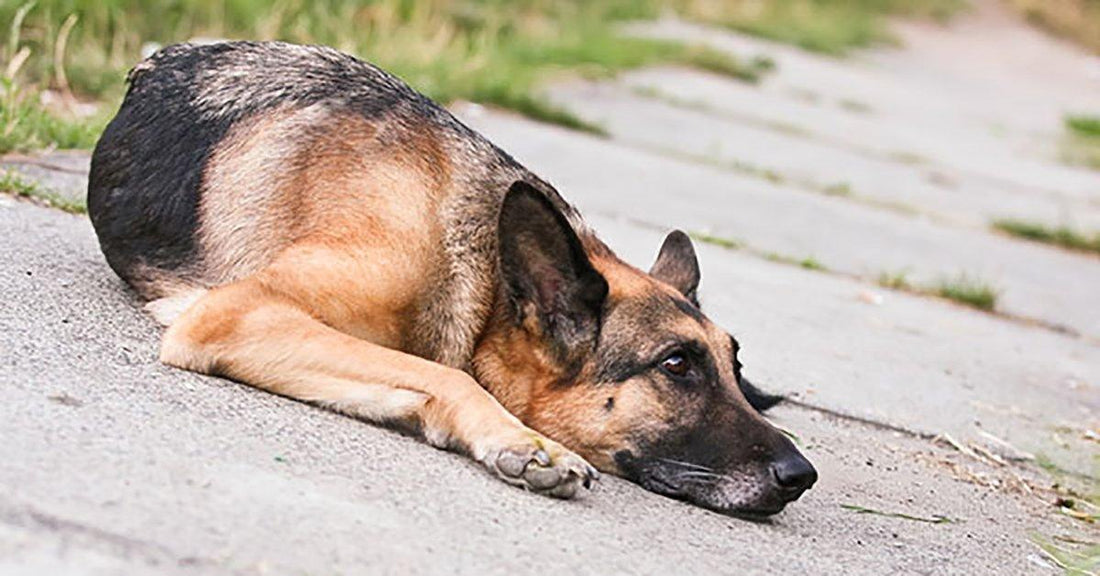Identifying Elbow Dysplasia in German Shepherds

Elbow dysplasia is a disease caused by a developmental defect in some dogs. The symptoms frequently cause lameness (limping) in a dogs front legs. There are multiple diseases of the elbow that cause elbow dysplasia but a dog only has to have one of them to be diagnosed with the disease.
Dogs most prone to elbow dysplasia include:
- Golden Retriever
- Labrador Retriever
- English Setter
- English Springer Spaniel
- Rottweiler
- German Shepherd Dogs
- Bernese Mountain Dog
- Chow Chow
- Chinese Shar-Pei
- Newfoundland
What is Elbow Dysplasia?
When a dog has elbow dysplasia the bones that make up the elbow joint don’t fit together properly and the elbow can’t stand the normal wear of life. The condition eventually causes pain whenever the forelimb is moved and may eventually cause arthritis.
Elbow dysplasia with arthritis is caused by the movement within the joint because the bones aren’t aligned properly, this disease is commonly confused by owners who think its part of the normal aging process for dogs.
Trauma to the elbow joint can also lead to changes within the elbow that mimic elbow dysplasia, but this disease results from genetic factors that cause abnormalities in joint formation, not trauma.
Symptoms of Elbow Dysplasia:
Dogs who have elbow dysplasia may show signs of the disease by suffering from mild to moderate pain and lameness in their forelimbs as early as four months old or they may not have any symptoms until later in their life.
Even though the disease can manifest at any age, it is commonly diagnosed when dogs are around two years old. Dog owners frequently take the dog to the vet complaining of stiffness in the front legs but both elbow joints are usually affected.
How soon a dog will show symptoms is related to how severe the abnormality in the joint is. Dogs eventually develop arthritis (inflammation in the joint) from years of the parts of the joint rubbing against each other.
Diagnosis of elbow dysplasia is based on the dog’s history, X-rays that confirm changes to the joint, and a physical exam. On physical examination the vet may find pain when the elbow is manipulated. There may also be swelling, crepitus (a crunching noise) and a decrease in the range of motion the dog has. Many dogs have to be sedated during the physical exam because it’s very painful for them.
There are different types of elbow dysplasia and the vet may order a CT scan to identify which type of elbow dysplasia the dog has. In addition, arthroscopy surgery or open joint surgery is considered the best way to determine the extent of the damage in the joint.
Treatment of Elbow Dysplasia:
There isn’t a cure for elbow dysplasia but there are treatment options for the disease, and they vary according to which form of the disease the dog has and what stage the disease is in.
- Surgical removal of cartilage - In dogs that are in the early stages of elbow dysplasia it’s possible to remove loose cartilage and smooth out the remaining cartilage in the joint. If arthritis has already set in it is more difficult to know how beneficial this surgery will be.
- Arthroscopic surgery (surgically inserting a scope) -is considered the best option for cases that are good candidates for surgical intervention.
- Open joint surgery – may also be the best option for some cases. Board-certified veterinary surgeons are advisable for the surgical diagnosis and treatment of all forms of elbow dysplasia.
- Elbow replacement surgery – is currently being researched, but still unavailable.
Non-Surgical Options:
We can manage pain by treating dogs with pain relieving drugs and glucosamine and fatty acid supplements. However, due to the discomfort and debilitation a dog suffers from this disease, some dogs may have increased lameness and even a decreased lifespan.
Veterinary Cost:
Whether your dog is in early-stage pain or end-stage arthritis it’s expensive to treat elbow dysplasia. For young dogs who can benefit from surgical options, the cost of surgical diagnosis and treatment can range from $1,500 to $4,000 per elbow.
Prevention:
The best way to prevent elbow dysplasia is to prevent it from occurring by not breeding dogs can pass it to future generations. The Orthopedic Foundation of America (OFA) will grade elbows on a scale of I-III to assist breeders in the prevention of elbow dysplasia by removing affected pets from the breeding pool.
























